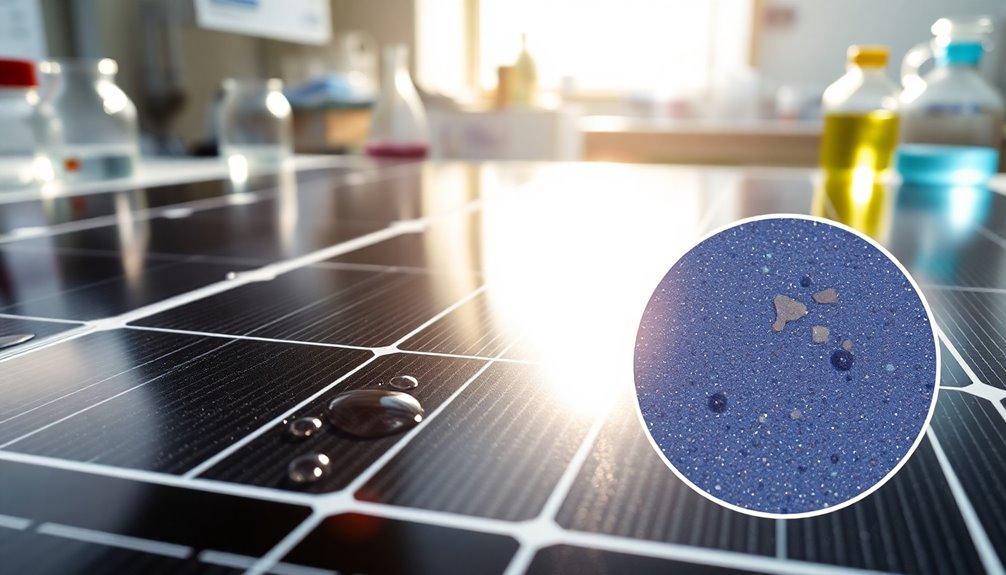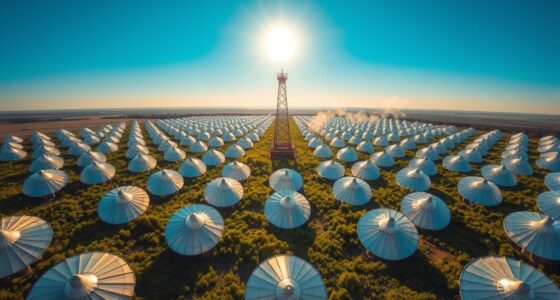PFAS are not commonly used in solar photovoltaic modules, as safer alternatives are available. Most adhesive and sealant options are PFAS-free, while substrates like Tedlar avoid PFAS during manufacturing. However, some self-cleaning coatings may still contain PFAS. Environmental and health concerns arise from improper disposal and potential leaching, posing risks. The industry is shifting toward PFAS-free materials to enhance sustainability. There's more to uncover about the ongoing changes and implications for solar energy.
Key Takeaways
- PFAS are rarely used in the production of solar photovoltaic modules, with safer alternatives available.
- Some self-cleaning coatings and adhesives may still contain PFAS, but many manufacturers opt for PFAS-free silicone.
- Environmental concerns arise from PFAS persistence in the environment and potential leaching from improperly disposed solar panels.
- Health risks associated with PFAS exposure include cancer and low birth weights, emphasizing the importance of sustainable practices.
- Recycling challenges exist for solar panels containing PFAS, necessitating proper disposal to mitigate environmental impact.

As concerns about environmental safety grow, understanding the role of per- and polyfluoroalkyl substances (PFAS) in solar photovoltaic modules becomes increasingly important. You might be relieved to know that PFAS isn't commonly used in solar panels, mainly because there are safer alternatives available.
While some self-cleaning coatings may contain PFAS-based chemicals, these substances don't break down under normal conditions, raising potential environmental concerns. However, when it comes to adhesives and sealants, solar panels predominantly utilize silicone-based options that are PFAS-free.
Some self-cleaning coatings may include PFAS, but solar panels primarily use PFAS-free silicone adhesives and sealants.
The substrates used in solar panels, like Tedlar, are also free from PFAS during manufacturing. Nevertheless, regulatory bodies are still vocal about the potential risks of PFAS near water sources, despite the lack of evidence showing significant leaching from these panels. It's crucial that you stay informed about these discussions, as they could impact solar energy policies in the future. Concerns over PFAS in solar panels have been raised by the Department of Public Health, highlighting the need for transparency in solar technology.
PFAS are notorious for their persistence and toxicity, linked to serious health issues such as low birth weights and higher cancer risks. If solar panels containing PFAS aren't disposed of properly, they can become environmental pollutants.
Recycling these panels poses challenges, as many don't feature recycling-friendly designs. If incinerated, solar panels may release PFAS into the atmosphere, which can be harmful to public health.
While some manufacturers, like Boviet Solar, are actively pursuing PFAS certification to ensure their products are safer, it's clear that the industry must focus on developing PFAS-free manufacturing alternatives.
In 2022, about 80% of solar panels still used PFAS in their outer layers, with only 20% opting for safer alternatives. As you consider the impact of solar energy, understanding these nuances around PFAS can help you make more informed choices.
Being aware of the health and environmental implications surrounding PFAS usage in solar panels is essential for supporting a sustainable future.
Frequently Asked Questions
What Are the Health Risks Associated With PFAS Exposure?
PFAS exposure poses several health risks that you should be aware of.
It's linked to increased cholesterol levels, obesity, and liver damage. Long-term exposure can raise your risk of kidney and testicular cancers, while also impairing thyroid function.
Additionally, you might experience immune system suppression, decreasing vaccine response and increasing infection risks.
For women, PFAS can impact fertility and pregnancy, potentially leading to developmental issues in infants.
Stay informed and take precautions.
Are There Regulations Governing PFAS in Solar Technologies?
Are there regulations governing PFAS in solar technologies? Yes, there are various regulations at federal, state, and local levels targeting PFAS.
The U.S. government requires companies to report PFAS usage, while states like Maine and Minnesota have banned products containing PFAS.
Local laws, such as in New York's Town of Avon, also prohibit using solar panels with PFAS.
Though federal rules specifically for solar panels are lacking, the trend towards safer alternatives is growing.
How Can PFAS Contamination Be Detected in Solar Modules?
To detect PFAS contamination in solar modules, you'll need advanced analytical techniques, like mass spectrometry, to identify these substances accurately.
Start by collecting samples from various components, such as back sheets and coatings.
You might also consider using environmental sampling methods, like groundwater testing near solar installations, to gather indirect evidence.
Given the industry's silence on PFAS, staying informed about regulatory updates and emerging detection methods is crucial for effective monitoring.
What Alternatives to PFAS Are Available for Solar Module Production?
When considering alternatives to PFAS for solar module production, you'll find several viable options.
Non-hazardous coatings like silicon-based self-cleaning solutions work well, and Tedlar, a non-PFAS polymer, serves effectively as a substrate.
You can also explore fully recyclable materials and silicone polymers for adhesives, which are safer choices.
These alternatives not only match or exceed PFAS performance but also reduce environmental risks associated with traditional materials.
How Do PFAS Affect Solar Panel Efficiency Over Time?
Isn't it ironic how something like PFAS, known for its persistence, mightn't even affect solar panel efficiency?
You won't find evidence that PFAS impacts performance over time, as they're not typically part of the photovoltaic cells.
However, environmental stressors can degrade coatings, influencing efficiency.
So, while PFAS could enhance durability, it's the weather and UV light that really challenge your solar panels' long-term performance.
Conclusion
In conclusion, understanding PFAS usage in solar photovoltaic modules is crucial for mitigating environmental risks. As the saying goes, "an ounce of prevention is worth a pound of cure." By assessing these chemicals' effects, we can better protect our ecosystem and ensure the sustainability of solar technology. It's essential to stay informed and proactive about these issues to harness solar power's full potential while safeguarding our health and environment.










